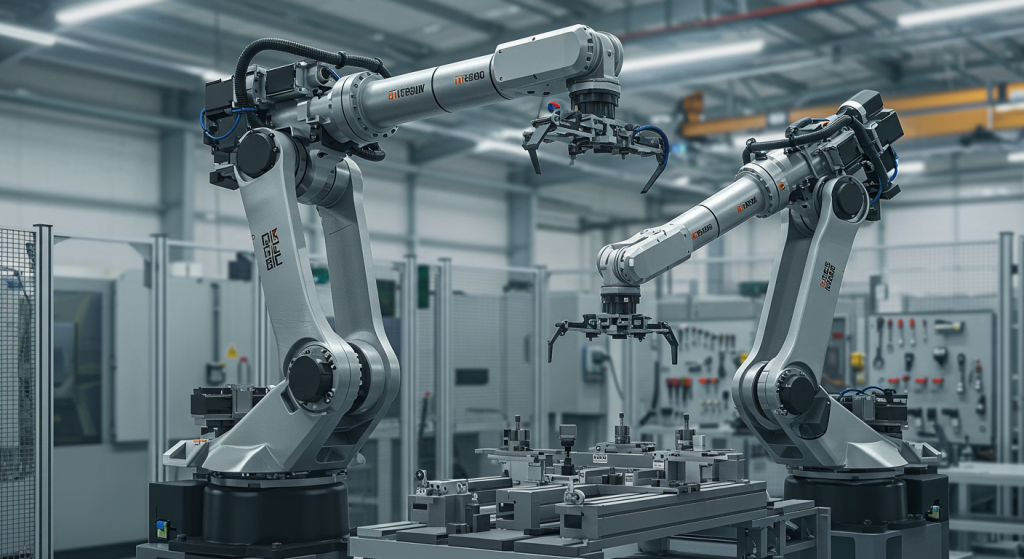Best Parallel Robots for Industrial Use: Boost Efficiency
What are the Best Parallel Robots for Industrial Use?
The best parallel robots for industrial use (or parallel kinematic machines (PKM)) are robotics systems that are uniquely designed with multiple arms/legs operating at once to create specific mechanisms of motion. Where serial robots rely on a single chain of movement, parallel robots utilize multiple chains, and by working in tandem, they create repeatable, precise, and dynamic operations.
Delta Robots: The Best Parallel Robots for Industrial Use
Delta robots are among the best parallel robots for use in industrial applications. Delta robots are parallel and provide the best levels of performance for high-speed automation applications. These robots are fast, working for 60 to 120 cycles per minute, which makes them well-suited to pick and place technology that works on many of today's production lines. The Delta robot boasts one of the most unique characteristics of its travel range; it can travel as long as 1600mm. This provides a wide variety of distances for extensive applications. The large travel range allows Delta robots to work on large scales, giving many manufacturers the flexibility they require to adjust their production lines based on operational needs.
Advantages of Parallel Robots in Industrial Automation
• Speed and Efficiency: Parallel robots are capable of completing high-speed tasks quickly and accurately in industrial settings where high performance is needed.
• Precision and Repeatability: Electronics assembly and pharmaceutical applications require devices that can accurately repeat the same function over and over again, down to the micron. Thus, parallel robots are best employed with such tasks.
• Increased Production Rates: Parallel robots provide consistent operation to allow faster cycle times for companies looking to boost production rates without compromising product quality.
• Financial Advantages: Employing parallel robots for intensive repetitive tasks lowers labor costs as a financial advantage of automated solutions. The repeatability and consistency of parallel robots, when paired with error avoidance, help prevent expensive manufacturing errors.
Performance Features of Parallel Robots
High-Speed Operation
Another situation in which parallel robots work to a user's advantage is in high-speed endeavors. For many activities with the need for extreme speed—pick and place activities, packaging robots—parallel is the way to go. They can handle high cycle times and thus, are ideal for high throughput robotics in food manufacturing, for instance, and consumer product electronics.
Precision and Accuracy
Whenever an application requires delicate handling, parallel robots are the best option. Due to their kinematic composition, they repeat motions with robot repeatability, making them excellent for projects requiring high-precision robots in assembly line settings with specific requirements.
High Payloads and Dynamic Performance
When critical operations need to achieve both high speed and high payload capacities, parallel robots are a good choice. Stewart platform robots are used in aerospace production for their ability to maneuver large components, their high payload capacity needs, and the necessity to shift large pieces gently yet rapidly.
Kinematic Accuracy and Control Systems
Parallel robots have outstanding kinematic repeatability because their motion is predetermined. It's easy to implement parallel robots into any automated system with excellent robot performance control.

How to Choose the Best Parallel Robots for Industrial Applications?
Choosing the best parallel robots for your industrial applications depends on a few factors:
Application Needs: Does your application require super-fast operations, heavy payloads, or delicate handling?
Integration with Existing Systems: Will the robot need to work with existing performance systems, and how can robot system integrators customize it for integration?
Robot Performance Standards: What are the standards of the robot's capabilities for repeatability and dynamic performance?
Pricing and ROI: Evaluating the pricing of the robot and the anticipated return on investment is vital. If robotic systems need to operate for extended periods with little maintenance, investing in higher-end robotics will be worth it over time.
Industries that Utilize Parallel Robots
Pharmaceutical Industry
The pharmaceutical sector needs precise robotics to fill vials, assemble components and products for medical devices, and package pharmaceuticals. Since precision is key to the industry's quality control requirements, parallel robots offer the needed precision.
Automotive Industry
Automotive industries depend on automated manufacturing systems as assembly line components. Many parallel robots are used for welding, painting, and assembly. Precision is critical for automotive industries, as parts must fit perfectly and defect reduction must occur.
Food Processing
Superseded by sorting, packaging, and palletizing are other operations where robots are used in food processing. Food processing robotics are often delta robots that work with high speed but can sort and package delicate food materials without damage.
Conclusion
Ultimately, these are the ultimate parallel robots for your industrial use. They take processing speed, accuracy, and flexibility to another level, whether in a pharmaceutical setting or for food processing. Understanding which precise type of robot works for different applications gives business owners insight into performance and efficiency increases, dependable quality control and quality assurance, and ultimately, profitability. For more information on industrial robots, be sure to contact Warsonco Robotics and get the perfect match for your industry today.















